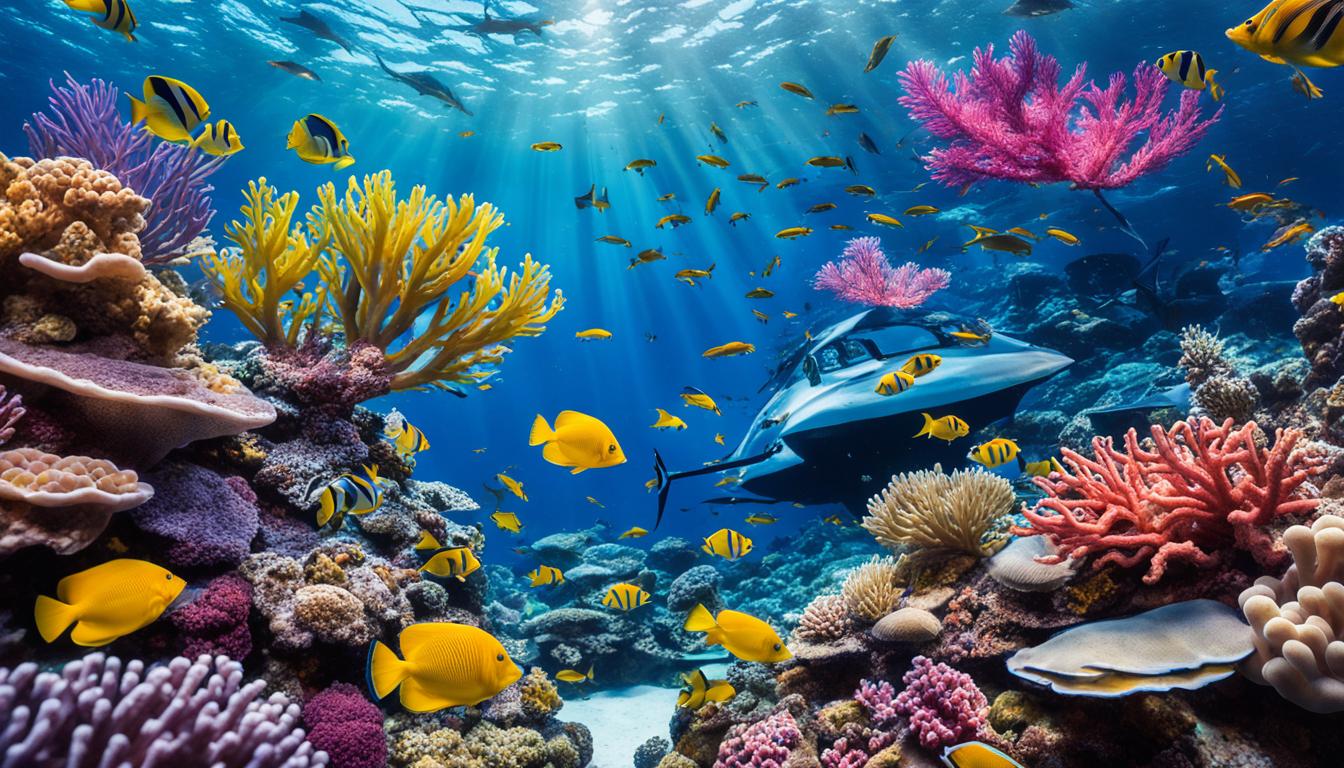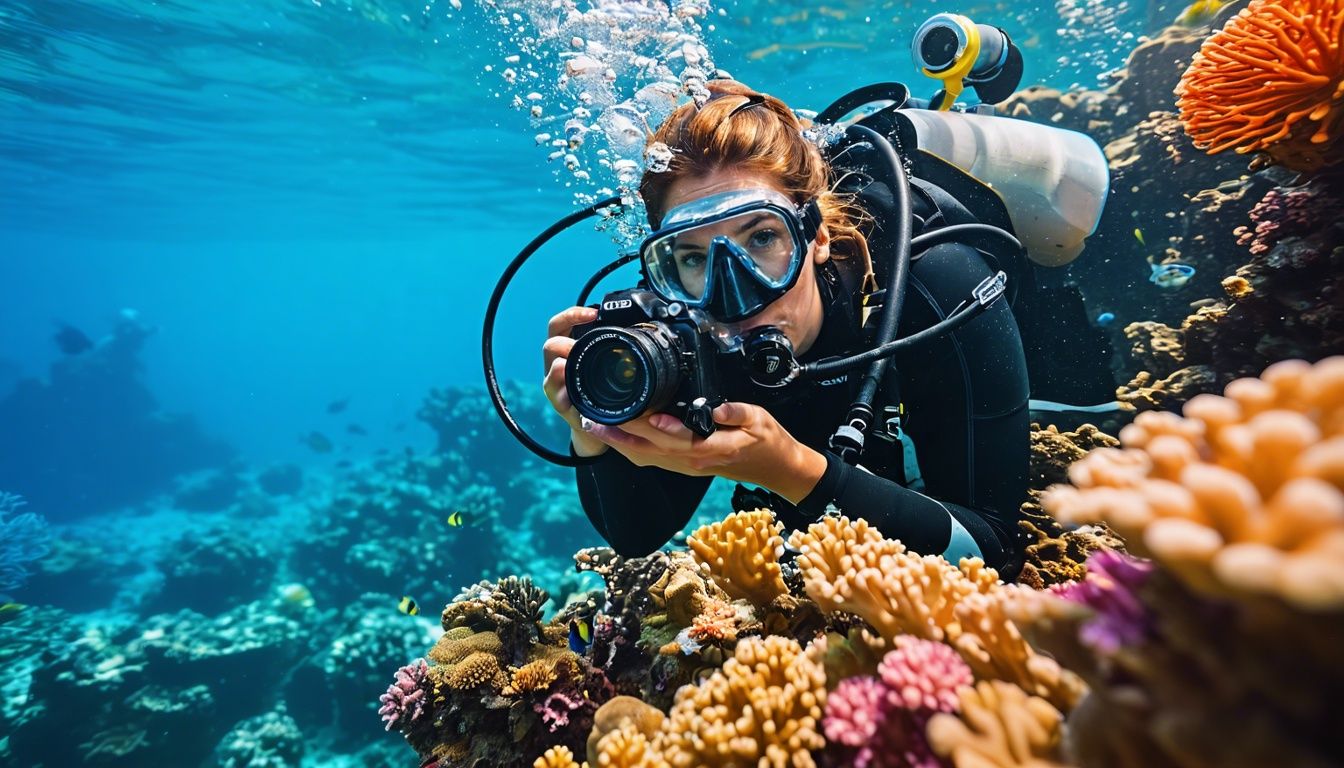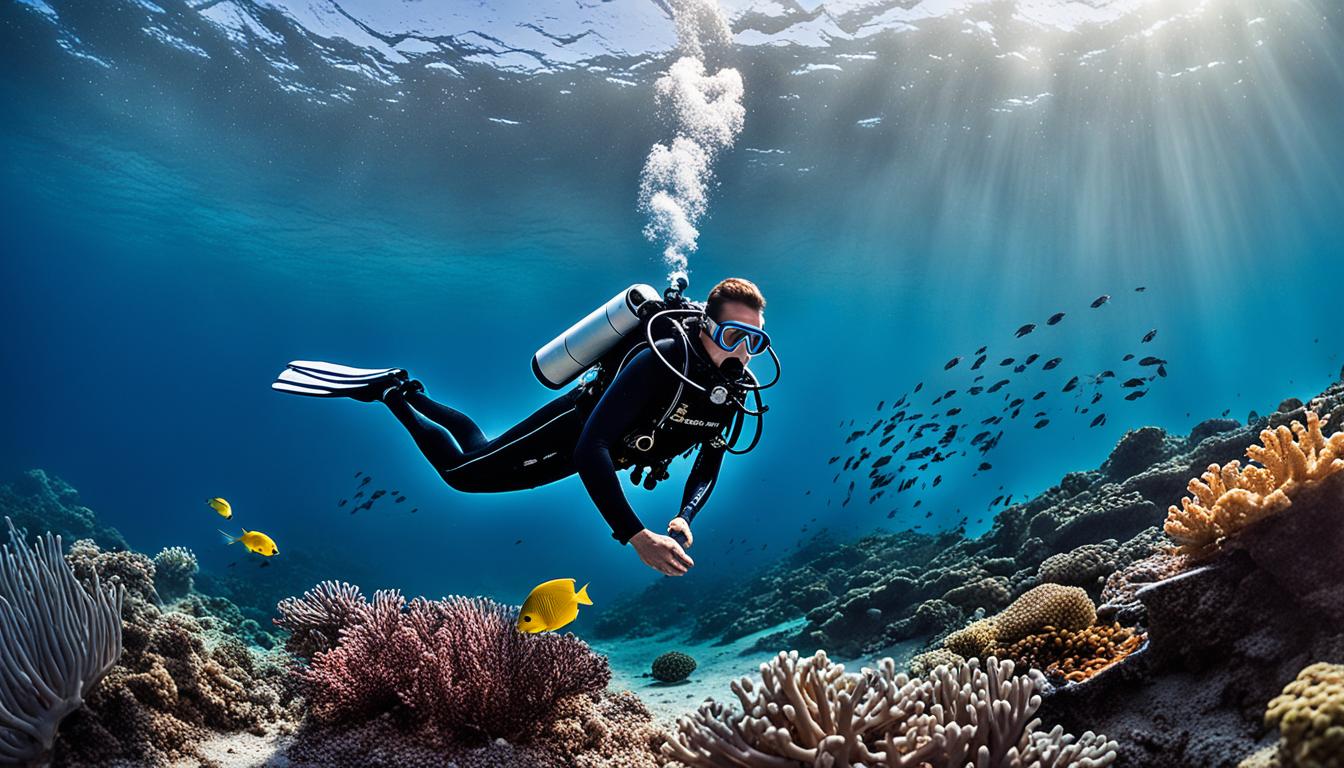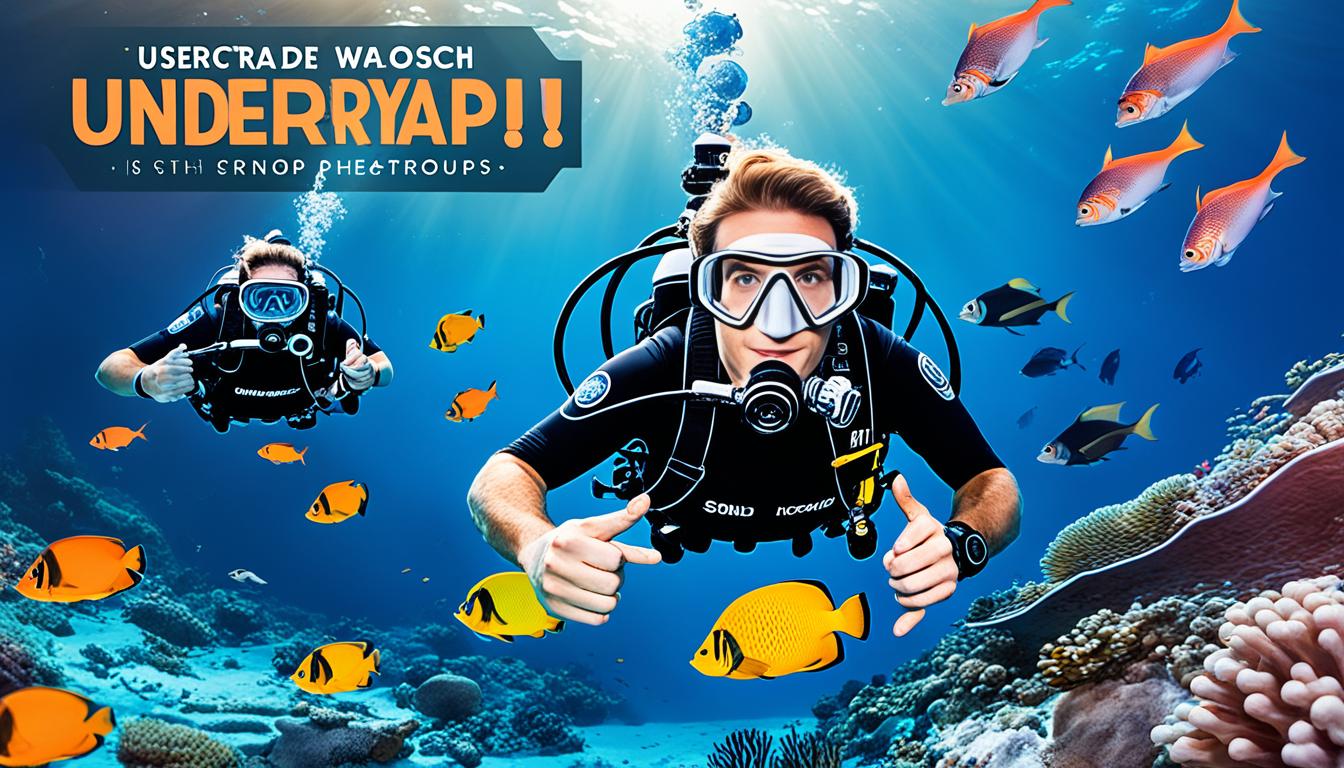Welcome to our guide on composition and framing in the aquatic environment. Whether you’re an experienced underwater photographer or just starting out, there’s always room for improvement when it comes to capturing mesmerizing underwater scenes. In this article, we’ll explore various techniques and tips that can help you elevate your underwater photography to new heights. From filling the frame to utilizing leading lines and framing techniques, we’ll cover it all. So, grab your camera and let’s dive in!
Key Takeaways:
- Composition is crucial in underwater photography, and the “fill the frame” technique can result in dynamic compositions.
- Understand the rule of thirds and apply it to capture captivating water scenes and highlight marine life.
- Utilize leading lines, such as coral reefs and schools of fish, to create depth and interest in your underwater landscapes.
- Experiment with framing techniques using natural elements like coral arches to add context and creativity to your shots.
- Getting up close to marine life allows you to capture intricate details and personalities, enhancing the overall impact of your photos.
Now that we’ve laid the groundwork, let’s delve into each technique in detail and discover how to master composition and framing in the aquatic environment!
Understanding the Rule of Thirds
The rule of thirds is a fundamental composition principle used in various forms of photography, including underwater photography. It involves dividing your frame into a tic-tac-toe grid and placing key elements of your composition along the intersecting lines or at the points where the lines meet. By adhering to this rule, you can create balanced and visually appealing images.
When taking underwater photos, applying the rule of thirds can help you capture captivating water scenes and highlight the beauty of marine life. By strategically positioning your subject or points of interest along these grid lines, you can create a sense of balance, depth, and visual interest in your underwater photographs.
Let’s take a look at an example:
“The rule of thirds helped me capture an incredible shot of a vibrant coral reef teeming with marine life. I positioned the main coral formation along the right vertical line of the grid and placed a school of colorful fish at one of the intersecting points. The resulting image had a harmonious composition, drawing the viewer’s eye to both the coral reef and the fish, creating a dynamic and visually striking scene.”
As you can see, by utilizing the rule of thirds, you can create balanced and visually appealing underwater photographs that capture the essence of the aquatic environment and the wonders of marine life.
Framing with the Rule of Thirds
Combining the rule of thirds with framing techniques can take your underwater photography to the next level. By placing natural elements such as coral arches or seaweed along the grid lines, you can create a frame that adds depth, context, and visual interest to your images. The frame helps draw the viewer’s attention to the subject and enhances the overall composition of your photo.
Here’s an example:
“By positioning a beautiful coral arch along the left vertical line of the rule of thirds grid, I created a natural frame around a majestic sea turtle swimming through the clear blue water. The result was a captivating image that showcased both the elegance of the sea turtle and the intricate details of the coral arch, all enhanced by the framing effect.”
By incorporating the rule of thirds and framing techniques into your underwater photography, you can create visually stunning compositions that capture the essence of water scenes and the beauty of marine life.
Utilizing Leading Lines for Depth and Interest
When it comes to capturing captivating aquatic landscapes, one technique that can significantly enhance your underwater photography is the effective use of leading lines. These lines, whether naturally occurring or man-made, serve as pathways that guide the viewer’s eyes through the frame, creating a sense of depth and drawing attention to specific elements within the composition.
Underwater, you have a wealth of opportunities to incorporate leading lines into your shots. The majesty of coral reefs, the subtle patterns of sand ripples, the mesmerizing movements of schools of fish, or even the graceful motions of sea turtles can all serve as prominent leading lines that add visual interest.
By strategically positioning these leading lines in your compositions, you can take your viewers on a visual journey, inviting them to explore the underwater world alongside you. The lines create a sense of wonder and exploration, making your images more immersive and compelling.
Connecting the Viewer to the Subject
Leading lines not only enhance the overall aesthetics of your aquatic landscapes but also play a crucial role in connecting the viewer directly to your intended subjects. By consciously composing your shots with leading lines, you can guide the viewer’s gaze toward the key elements that you want to highlight in your photograph, whether it’s the extraordinary beauty of coral formations or the vibrant colors of underwater plants.
By utilizing leading lines, we can create a visual pathway, drawing the viewer’s attention precisely to where we want them to look. It’s like taking their hand and guiding them through the depths of our underwater compositions.
Creating a Sense of Depth
Depth is a crucial element in underwater photography as it adds dimension and realism to the captured scenes. Leading lines play a pivotal role in creating this perception of depth. As the lines converge and recede into the distance, they provide a visual cue for the viewer to perceive the varying distances within the frame.
These leading lines can be witnessed in the form of parallel lines running alongside each other or diagonal lines cutting through the composition. Regardless of the type, their presence adds a layer of depth to the image, immersing the viewer in the vastness of the underwater environment.

Experimenting with Leading Lines
As an underwater photographer, don’t be afraid to experiment with different types of leading lines and their positioning within your compositions. This creative exploration allows you to find unique and interesting perspectives that showcase the beauty of aquatic landscapes.
Here are a few ideas to get you started:
- Frame your subject with the natural curves and arches of coral formations.
- Feature the dynamic movements of marine life, like fish swimming in schools or sea turtles gliding through the water.
- Use the patterns created by sand ripples or the texture of underwater plants to guide the viewer’s eyes.
Remember, leading lines are powerful visual tools that enable you to create impactful underwater photographs. Harness their potential to transport your audience into the mesmerizing world beneath the waves.
The Power of Framing in Underwater Photography
When it comes to underwater photography, framing is a powerful technique that can elevate your shots and unleash your creativity. By incorporating natural elements like coral arches or seaweed silhouettes, you can add depth, context, and a unique artistic touch to your underwater photos.
Framing allows you to guide the viewer’s attention to the main subject while creating a visually captivating composition. It adds a sense of dimension and perspective, making your images more engaging and memorable.
When you find the perfect frame underwater, take a moment to evaluate the angle and perspective. Experiment with different positions, distances, and compositions to achieve the desired effect. Don’t be afraid to get close to your subject and use the frame to create a seamless connection between the foreground and the background.
“I was swimming through a mesmerizing coral reef, surrounded by vibrant marine life. As a school of colorful fish swam by, I noticed a perfect coral arch framing the scene. I positioned myself to capture the moment, with the fish gracefully passing through the arch. The result was an enchanting image that showcased the beauty of the underwater world and the interaction between the marine life and their natural habitat. Framing truly transformed an ordinary shot into a storytelling masterpiece!”
Remember, framing is not limited to static elements like coral or seaweed. It can also be created using the natural movements of marine life. For example, capture a majestic sea turtle swimming through an opening in the coral, or a playful dolphin framed by the waves. These dynamic frames add a sense of movement and energy to your photos.
By mastering the art of framing, you can unlock endless creative possibilities in your underwater photography. Experiment, explore, and let your imagination soar as you capture stunning and unique moments beneath the surface.
Tips for Effective Framing in Underwater Photography:
- Look for natural frames like coral arches, seaweed, or rock formations.
- Experiment with different angles and perspectives to find the most captivating composition.
- Move closer to your subject to create a seamless connection between the frame and the main subject.
- Utilize the movements of marine life to create dynamic and engaging frames.
- Consider the lighting conditions and how it interacts with your chosen frame.
Getting Up Close and Personal with Marine Life
When it comes to underwater photography, there’s nothing quite like getting up close and personal with marine life. This approach allows us to capture the intricate details and unique personalities of the creatures that inhabit the underwater world. Whether our lens focuses on the delicate beauty of seahorses, the fascinating movements of shrimps, or the vibrant colors of nudibranchs during macro photography, or if we’re lucky enough to encounter larger marine creatures like majestic manta rays, getting close to our subjects ensures that they stand out in the frame.
One important aspect to consider when getting close is the clarity of our shots. The amount of water between us and our subjects can have a significant impact on the overall image quality. To achieve the best results, we need to pay attention to our positioning, lighting, and camera settings, adjusting them accordingly to capture clear and sharp details while maintaining the natural atmosphere of the underwater environment.
Remember, marine life photography isn’t just about capturing the visual appearance of the creatures we encounter; it’s also about conveying their essence and showcasing their unique behaviors. By getting up close and personal, we can create photographs that not only document the beauty of marine life but also tell captivating stories that inspire and educate viewers about the precious and fragile underwater world.
So, let’s don our diving gear, grab our cameras, and dive into the depths to explore the wonders of marine life through the lens of underwater photography.

Quick Tips for Getting Up Close:
- Use a macro lens or suitable lens attachments to capture small and intricate details.
- Be patient and observe the behavior of marine creatures to understand their movement patterns and preferred areas.
- Practice good buoyancy control to avoid disturbing or damaging the underwater environment.
- Experiment with different angles and perspectives to highlight the unique features and behaviors of each subject.
- Always prioritize the safety and well-being of marine life, maintaining a respectful distance and avoiding any harmful interactions.
By utilizing these techniques and approaching marine life with respect and appreciation, we can create remarkable images that showcase the mesmerizing beauty of underwater creatures.
Conclusion
Mastering composition and framing techniques in the aquatic environment is essential for creating stunning underwater photographs. By incorporating techniques such as “fill the frame,” the rule of thirds, leading lines, framing, and getting up close to our subjects, we can elevate our underwater photography to new heights.
Experimenting with different approaches and being patient with ourselves, we can allow our creativity to shine through our images. With dedication and practice, we have the opportunity to capture the breathtaking beauty of the underwater world and create photographs that inspire and captivate.
Remember, underwater photography is a journey of exploration and self-expression. By utilizing the underwater photography techniques we’ve discussed, we can capture the mesmerizing water scenes and preserve the wonders of the aquatic environment in our images.
FAQ
What is composition in underwater photography?
Composition refers to the arrangement and placement of elements within a photograph. In underwater photography, it involves how you position your subject, the use of lines, framing techniques, and the overall balance and visual appeal of your image.
How can I improve my underwater photography composition?
There are several techniques you can use to improve your underwater photography composition. These include “fill the frame” by getting close to your subject, using the rule of thirds, incorporating leading lines, and utilizing natural frames such as coral arches or seaweed silhouettes.
What is the rule of thirds in underwater photography?
The rule of thirds is a composition principle that involves dividing your frame into a tic-tac-toe grid. You place key elements along the intersecting lines or at the points where the lines meet. By adhering to this rule, you can create balanced and visually appealing images in underwater photography.
How can I use leading lines in my underwater photographs?
Leading lines are natural or man-made lines in a photograph that guide the viewer’s eyes through the frame and create a sense of depth. In underwater photography, you can utilize coral reefs, sand ripples, schools of fish, or the movements of marine life as leading lines to capture visually engaging underwater landscapes.
What is framing in underwater photography?
Framing is a technique in underwater photography that involves using natural elements such as coral arches or seaweed silhouettes to frame your subject. This adds depth, context, and visual interest to your photos. By incorporating frames into your compositions, you can create visually stunning and creative underwater shots.
How can I capture the intricate details of marine life in underwater photography?
Getting up close to your subjects is essential in underwater photography to capture the intricate details and personalities of marine life. Whether you’re photographing macro subjects like seahorses or larger creatures like manta rays, getting close ensures that your subjects stand out in the frame. Pay attention to the clarity of your shots, as the amount of water between you and the subject can affect the overall image quality.
How can mastering composition enhance my underwater photography?
Mastering composition in underwater photography can enhance your images by creating visually appealing and balanced compositions. By utilizing techniques such as “fill the frame,” the rule of thirds, leading lines, framing, and getting up close to your subjects, you can elevate your underwater photography and capture the breathtaking beauty of the underwater world.
How Can Framing Techniques in Event Photography be Applied to Underwater Composition?
When mastering event photo composition, it’s important to understand framing techniques. This also applies to underwater photography. By utilizing elements like leading lines, symmetry, and negative space, photographers can create visually striking compositions underwater. Understanding how to frame a subject can greatly enhance the overall impact of the photo.




